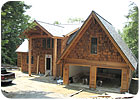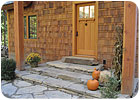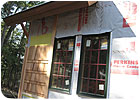
Charlie Perry is on a crusade to change the way homes are built and insured in the United States and he’s beginning his campaign right in his own house, with his own money.
For many years Perry has been a consultant to the insurance and real estate industries, and has been distressed to see that coverage for mold damage has quietly been excluded from American homeowner policies. “Nobody can get homeowner coverage for mold damage in the United States,” Perry toldWalls and Ceilings. “And in those rare instances where there is an exception, it’s way too expensive.”

FIRST MOLD-SAFE HOUSE
To solve the problem, Perry has built what he and industry experts consider to be the first “Mold-Safe Home” in the United States. And he built it with his own money, with no financial assistance from anyone or any organization, and he made sure the 4,000-square-foot, two-story house looked like any other house in Spofford Lake, Conn., where it overlooks a lake and is surrounded by picturesque pine trees. The location is near the nexus of Vermont, Massachusetts, and New Hampshire. The area experiences summer temperatures reaching nearly 100 degrees and winters where it is common to have temperatures in the 20-degree-below-zero range.Perry, 58, is a principal in Environmental Assurance Group, a risk management and real estate consulting firm. He said the most important decision he made was not to use paper-faced drywall. Instead, he used DensArmor Plus paperless drywall, which is gypsum faced with fiberglass.
“When there is an incidence of mold in any residence, somewhere between 84 percent and 93 percent of the time it is found in the drywall paper,” Perry explained, adding that paper is a nutrient that most species of mold find most delicious. If wallpaper is in the home, the percentage is even higher.
Additional products used for the home include:
• A coating for lumber manufactured by American Mold Guard.
• Typar Fiberweb housewrap.
• Home Slicker rainscreen by Benjamin Obdyke.
• Optima Membrain insulation by CertainTeed.
• Windows by Bonneville, a Canadian firm.
Perry stressed that the added cost–about $2,000– for all of the mold-resistant materials is really negligible considering the beneficial effect they will have in the long run. “When you are talking about the final cost of a house topping $200,000, the added cost for these materials is less than 2 percent.”
NORMAL-LOOKING ON THE OUTSIDE
Aside from the specialized materials that nobody could see once the house was finished in October, it was built predominantly from native New England wood and stone and has been modeled after an old-style lodge. It has three bedrooms and bathrooms, a large kitchen and living area, cherry wood floors, an office, and a walk-out basement.“The most important thing is to show people this new, efficient technology without making them feel like they have to live in a steel box,” said Perry, who now lives in the house with his wife.
Perry is well connected with local and national organizations that are promoting “smart building practices,” designed to make homes safe. Indeed, his home has been featured in national media and many manufacturers issued press releases announcing their involvement in the project.
Although he financed construction of his home, his effort is sponsored by the Partnership for Advancing Technology (PATH), a partnership of industry and government officials whose mission is “to promote the use of technologies that improve the quality, durability, energy efficiency, environmental performance, and affordability of America’s housing.”
Perry said the house is as mold-resistant as any structure can possibly be, and he has been in negotiations with some of the major home insurance underwriters to see if they are willing to revamp their approach to insurance for mold.
His efforts are having an impact, he said. “We wanted to see how many insurance companies would be interested. We went after six or seven, and have gotten six who are. There has been a good reaction; we are in the process of crafting language for policies and expect the first policies to be written this fall, with mold coverage, and discounts from mold-safe building materials.”

THE PETRI-DISH PROBLEM
As it stands, according to President of the American Risk Management Resources Network Dave Dybdahl, the exclusion of all mold insurance in the U.S. was a sound business decision. He specializes in environmental mold insurance, and has been watching the situation closely, for years.Recent trends in the approach to building homes have created a looming crisis, he said. “With the increasing cost of energy, more gravity to use more insulation, we have problems. More insulation makes it more difficult for a building to breathe, and that causes water accumulation in walls. Some people are building Petri dishes on a wide scale. Some buildings are uninsurable,” he said.
The dangers and causes of mold are well known; certain categories of the sometimes-invisible spores can be fatal.
“Insurance companies saw by 2002 that mold-related damage was becoming a source of new losses for them, so they got insurance commissioners in all 50 states to approve the introduction of mold and fungus exclusions. These are now universally present,” he said.
A big problem, Dybdahl said, is “they don’t teach building science in architecture or building school. If you are not using building science in the design of the building, the chances of building a building that will fail because of moisture in the walls is actually high. Building codes were not designed to address moisture intrusion. They were designed for fire and safety. Nobody had an eye toward water intrusion and moisture accumulation. Some new construction techniques are more risky than the old. That is what the professional risk-takers saw, and they got out.”
Perry said his new home is going to be continually monitored to see exactly how mold-safe it is. “So far things are going great. I have a new house and it’s very comfortable.”



